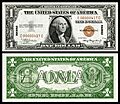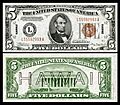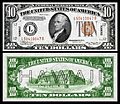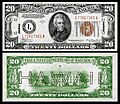Hawaii overprint note facts for kids
| (United States) | |
|---|---|
| Value | $1, $5, $10, $20 |
| Years of printing | 1942 – 1944 |
| Nature of rarity | Emergency Issue |
| Estimated value | US$2 - $1,300 |
| Obverse | |
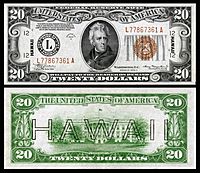 |
|
Hawaii overprint notes are special banknotes that were made during World War II. These notes were created as an emergency measure right after the attack on Pearl Harbor in 1941. The main idea behind these notes was to make it easy to tell them apart from regular US money. If Japanese forces had invaded Hawaii and captured a lot of US currency, the government could quickly make these special "Hawaii" notes worthless. This would stop the enemy from using the money.
Contents
Why Special Notes Were Made
After the surprise attack on Pearl Harbor, military leaders worried about a possible Japanese invasion of Hawaii. They thought that if an invasion happened, the enemy might get their hands on a lot of US money. This money could be taken from banks or from people living there.
Protecting Money in Hawaii
To prevent this, on January 10, 1942, the Military Governor of Hawaii, Delos Carleton Emmons, gave an important order. He said that all regular US money on the islands had to be turned in. People could only keep a small amount of cash. Individuals could have up to $200, and businesses could keep up to $500, unless they needed more for things like paying their workers.
How the Notes Looked
New special notes started to be given out on June 25, 1942. These notes were regular US bills, but they had some important changes:
- They had brown treasury seals and serial numbers instead of green ones.
- The word "HAWAII" was printed on them.
- Two small "HAWAII" overprints were placed on the front of the note. They were between the border and the seals.
- A large, outlined "HAWAII" was printed across the entire back of the note.
The goal was simple: if Japan invaded, the US government could immediately announce that all "Hawaii" notes were no longer valid. This made them easy to identify and stop the enemy from using them.
Switching to Hawaii Notes
Because of these new notes, regular US money became useless in Hawaii. Military officials told everyone living in Hawaii to exchange their old money for the new Hawaii overprint notes. This had to be done by July 15, 1942. After August 15, 1942, people could not use any other paper US currency without special permission.
When They Were Used
The Hawaii overprint notes were used until October 21, 1944. By April 1946, these notes were being called back by the government. Even though they were recalled, they are still considered legal tender today at their original face value. Many soldiers and collectors kept these notes as cool souvenirs from the war.
Collecting Hawaii Notes
These special notes are popular with collectors.
- The $5 note is often seen as the most wanted because fewer of them were printed (just over 9 million).
- Over 35 million $1 notes were made, so they are the most common ones to find.
- Some of these notes are also "Star notes." These are replacement notes printed when a mistake was made during the original printing. Star notes are much rarer and can be worth a lot more money to collectors.
| Denomination | Quantity Printed | Star Note Quantity Printed |
|---|---|---|
| $1 | 35,052,000 | 204,000 |
| $5 | 9,416,000 | ? |
| $10 | 10,424,000 | ? |
| $20 | 11,246,000 | 54,500 |
Images for kids


